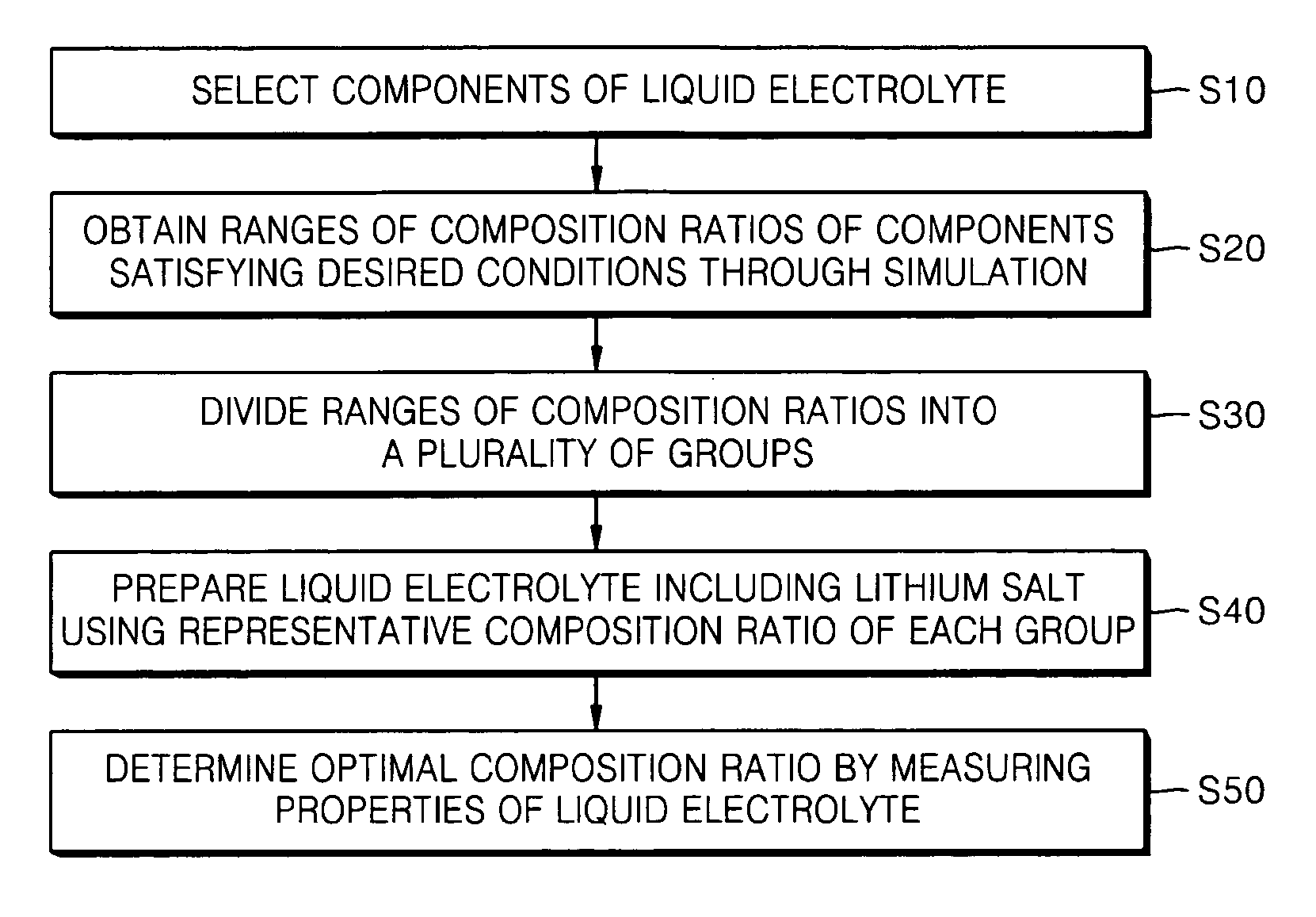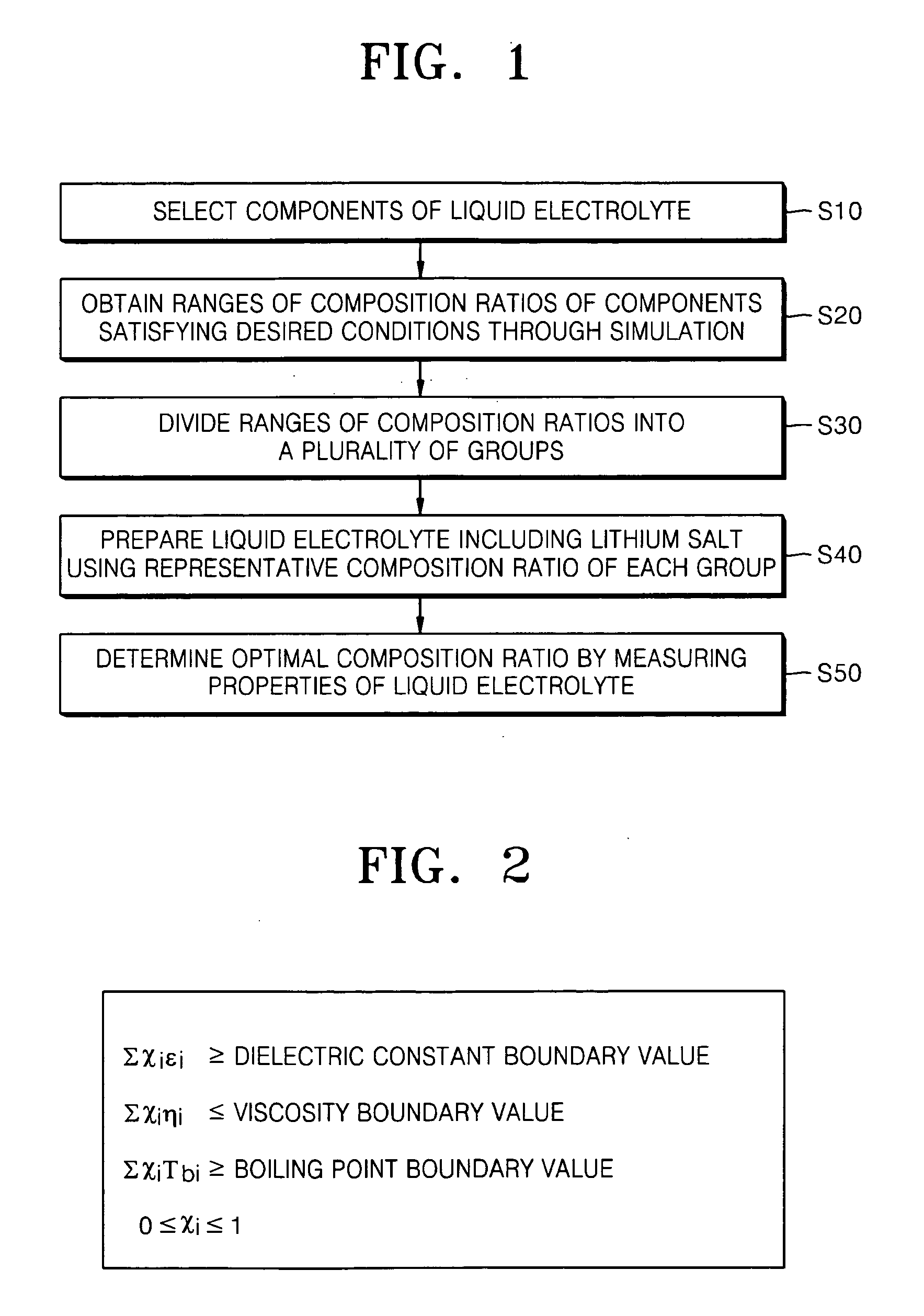Method of designing composition of liquid electrolyte for high charge/discharge rate
- Summary
- Abstract
- Description
- Claims
- Application Information
AI Technical Summary
Benefits of technology
Problems solved by technology
Method used
Image
Examples
example 1
[0041]A liquid electrolyte consisted of three organic solvents: ethylene carbonate, dimethyl carbonate, and dimethyl formamide. An optimization program for a composition ratio simulation was operated in which a three-component-based mode was selected, the dielectric constant, viscosity and boiling point of the three organic solvents were input, and a boundary condition was set such that the average dielectric constant was 50 or more, the average viscosity was 1.2 cP or lower, and the average boiling point was 80° C. or more. Then, a simulation was performed under the conditions described above and ranges of composition ratios of the three solvents were calculated. The results are illustrated in a three-component-based graph like FIG. 3. The amount of ethylene carbonate was calculated to be in the range of 23 to 40% by weight, the amount of dimethyl carbonate was calculated to be in the range of 1 to 24% by weight, and the amount of dimethyl formamide was calculated to be in the rang...
example 2
[0043]A liquid electrolyte consisted of four organic solvents: ethylene carbonate, dimethyl carbonate, diethyl carbonate and ethylmethyl carbonate. An optimization program for a composition ratio simulation was operated in which a four-component-based mode was selected, the dielectric constant, viscosity and boiling point of the four organic solvents were input, and boundary conditions were set as in Example 1. The composition ratios obtained through the simulation of the optimization program are shown in Table 2, and divided into four groups and a representative composition ratio of each group was determined. Then, an organic solvent mixture was prepared using the respective representative composition ratios, and 1 M lithium salt was added thereto to prepare liquid electrolytes.
TABLE 2DiethylEthylmethylEthylene carbonateDimethyl carbonatecarbonatecarbonateGroup 153% by weight24% by weight1% by weight22% by weightGroup 253% by weight32% by weight2% by weight13% by weightGroup 353% b...
example 3
[0044]A liquid electrolyte consisted of three organic solvents: ethylene carbonate, dimethyl carbonate and tetrahydrofurane. Representative composition ratios shown in Table 3 were obtained in the same manner as in Example 1. Liquid electrolytes were then prepared using the respective representative composition ratios.
TABLE 3Ethylene carbonateDimethylcarbonateTetrahydrofuraneGroup 115% by weight25% by weight60% by weightGroup 225% by weight20% by weight55% by weightGroup 335% by weight15% by weight50% by weightGroup 4#45% by weight10% by weight45% by weight
PUM
 Login to View More
Login to View More Abstract
Description
Claims
Application Information
 Login to View More
Login to View More - R&D
- Intellectual Property
- Life Sciences
- Materials
- Tech Scout
- Unparalleled Data Quality
- Higher Quality Content
- 60% Fewer Hallucinations
Browse by: Latest US Patents, China's latest patents, Technical Efficacy Thesaurus, Application Domain, Technology Topic, Popular Technical Reports.
© 2025 PatSnap. All rights reserved.Legal|Privacy policy|Modern Slavery Act Transparency Statement|Sitemap|About US| Contact US: help@patsnap.com



